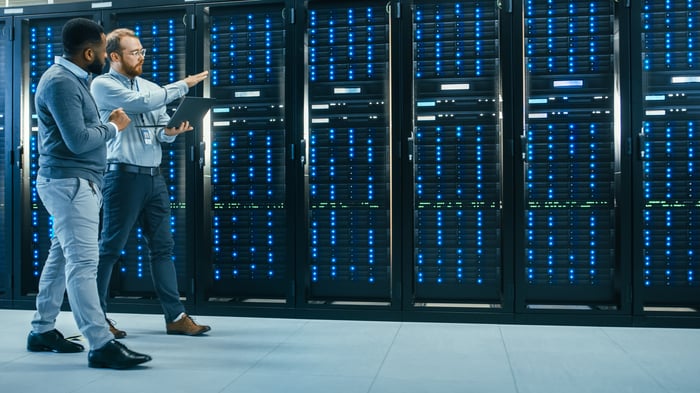Cisco Systems (CSCO 0.37%) posted fiscal first-quarter results in line with management's expectations. Yet, the stock dropped 5.5% the day after the report because of the underwhelming next-quarter outlook. So should investors stay away from the legacy tech giant, or should they take this opportunity to buy the dip?
Mixed results
Over the last several years, networking veteran Cisco has been transforming its hardware business that consists of selling devices that connect servers and data centers. As a result of internal developments and acquisitions, the company now proposes software subscriptions for collaboration solutions, cybersecurity offerings, cloud monitoring capabilities, and more.

Image source: Getty Images.
Amidst this transformation, Cisco delivered unsurprising results during the fiscal first quarter, which ended on Oct. 30. Despite supply chain constraints, revenue increased 8% year over year to $12.9 billion, driven by the broad-based strength of the company's portfolio. Investors should keep in mind that last year's 9% year-over-year revenue decline provided an easy base comparison for that high-single-digit revenue growth, though.
In any case, the transition to software is materializing. Revenue from software reached $3.7 billion, up only 1% year over year, as the transition to subscriptions involves lower ratable revenue recognized over several years in place of larger one-time sales involving perpetual licenses.
More worryingly, Cisco still underperformed its peers in some growth areas. For instance, the company's cybersecurity business increased 4% year over year to $895 million during the last quarter, prolonging a decelerating growth of 12% and 7% in 2019 and 2020, respectively. In comparison, cybersecurity competitors Palo Alto Networks and Fortinet have been generating much stronger double-digit revenue growth over the last several years thanks to their successful development of cloud offerings. Palo Alto and Fortinet also have to deal with legacy hardware solutions, just like Cisco.
Looking forward, management provided a disappointing outlook for the next quarter with anticipated revenue growth in the range of 4.5% to 6.5%. During the earnings call, CFO Scott Herren justified the modest guidance with worldwide supply chain constraints. But the company's challenges in some of its businesses, such as cybersecurity, could also play a role there.
Modest valuation
In any case, management maintained its full-year outlook of revenue and earnings-per-share (EPS) growth in the range of 5% to 7%. That suggests the supply chain situation will improve over the next several quarters.
Still, the disappointing next-quarter guidance sent the stock price 5.5% lower the day after the news. As a result, the stock is trading at only 4.2 times the midpoint of the company's anticipated full-year revenue.
In addition, despite pressure on its gross margins because of the global supply chain constraints, Cisco remains highly profitable thanks to its scale. Management expects full-year EPS to land in the range of $2.77 to $2.89, which corresponds to a price-to-earnings ratio of 19.0 at the midpoint.
Taking into account management's anticipated revenue and EPS compound annual growth rate of 5% to 7% by 2025, as discussed during the analyst day in September, those valuation ratios remain reasonable. In addition, the company accumulated $23.3 billion of cash, cash equivalent, and investments at the end of the last quarter, which provides a comfortable safety net in comparison to its total debt of $9.5 billion.
Of course, the company must still provide strong execution over the next several years to reach its long-term goals. It finally managed to update its cloud networking portfolio and become relevant with cloud giants after having left that attractive opportunity to competitors, such as Arista Networks, for several years. So with similar efforts, Cisco has the potential to also improve its competitiveness in challenged areas, such as cybersecurity, over time.
Thus, given the company's modest valuation and rock-solid balance sheet in the context of multi-year growth, long-term investors looking for exposure to the tech industry at a reasonable price should consider buying the dip.





